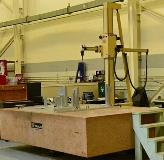CMM Retrofits vs. buying a new or used CMM
There are a few reasons buying a new or used CMM makes sense and other times where retrofit makes sense. Aside from needing a different size CMM, refurbishing/retrofitting your current CMM is usually an attractive option. With a CMM Retrofit, you’ll have a ‘like new’ machine and perhaps as important: an OEM neutral CMM controller (See the Neutral Controller section for details).
Factors to consider:
1. Scales
2. Neutral Controller
3. Software
Scales:
If you’re thinking about replacing your CMM, keep in mind that you could likely have a ‘like new’ CMM if you simply replace your scales. You’ll likely increase your scales’ resolution. The basic design of CMM structures haven’t really changed since the 80s and they rarely wear to the point of needing to actually replace them. Some symptoms that might lead you to replacing your scales are Faults that reference position errors, scale errors, custom chip rate errors, etc.
“The basic design of CMM structures haven’t really changed since the 80s and they rarely wear to the point of needing to replace them”
Neutral Controller – Taking back your CMM choices
Neutral controllers are one of the best ways to gain control of your lab and take back your ability to make choices. Depending on the motors you have on your CMM, there are multiple options for neutral controllers that will work with the majority of CMM software packages and CMM bases. Some of my favorites are those that allow you to use whatever software you have as if you’re using the original controller. Yes, there are good options that allow you to carry out probe calibrations as if you’re using the OEM’s controller.
Leverage vs. Good service – The advantage of having a neutral controller are:
1. Taking control of your inspection lab: If you stay with the OEM’s controller, most will leverage you into staying with their software and work towards forcing you to have everything serviced through them. Regardless of price or quality of service. A truly independent Metrology house will set you up so that you can use anyone to service your CMM. To you, this is a mechanism to ensure they provide the best service at competitive prices or face losing your business as anyone can service your CMMs if you have a neutral controller. Sound refreshing?
2. Having choices on software or multiple software packages on your CMM: Why may this important? Below are a few examples:
a. Pleasing your customer: If your customer wants you to use the software or even the exact program they’re using, a neutral controller can give you that flexibility. An independent metrology house can even help you interchangeably use different software solutions on the same machine!
b. A new CMM programmer knows another software: In the unfortunate event that you hire a new CMM programmer that know another software, having the option of using another software could keep your inspection lab running.
3. You can negotiate better prices on hardware: If the big OEMs know you are structurally married to them, you’ll have a chance in negotiating a fair market price. Otherwise, you’re stuck paying list price or close to it. It’s my experience that most manufacturers experience a short ROI by neutralizing their controller.
The Software Game: The big OEMs use the lure of standardization and streamlined solutions to make you think you need to buy everything from them. The reality is the OEMs benefit most from this approach, not you. Some of the most powerful, simple and cost-effective software solutions are the ones that ‘play well with others’.
If you’re considering a new CMM, we encourage you to take the time to talk to us about making your current CMM like new again or neutralizing your CMM controller.
The OEM’s argument for ‘our suite of products’: One argument used to have all your products under one roof is that you want your CMM results to flow seamlessly into, let’s say, your SPC package. A strategic quality manager would say “nice try”! A strong third-party SPC solution could be your best bet at both easing the leverage the big metrology OEMs have on your oppoerations and ensuring you can use any measurement devices you have on hand. Remember, the OEMs’ goal is to leverage you into standardizing because when OEMs don’t compete, they win. On the other hand, when OEMs do compete, you win.
To ensure control of your quality department, a good first step is to keep your reporting neutral. Here’s where to start: www.SPCnext.com
Written by: Brock LaHart – Consumer Advocate – Metrology Industry Consultant – President of MFG Next and SPC Next
Contact Brock at: 734-417-5799 or brocklahart@mfgnext.com

